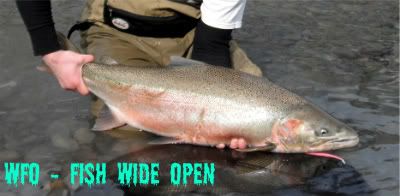So... does the interweb not reach Orygun or is Mr. Hall just way too cool to defend himself here? I watch the show maybe once a month but really don't like him. Seems like a little Glen goes a long way- just sayin. Ever notice how on every episode he can't remember one of his guests names?
He does not need to defend himself, if it was legal to do so when the video was made. Its an old video. 2002 to be exact. Umpqua has been a non retention river for a couple years thanks to some locals. They dont have hatchery fish, its all wild on the north fork and now you cant even use a weighted fly at least during the summer. This entire thread is a waste of time. Todays attitudes applied to every other region and time period that did not have the same problems that we do. They dont have Boldt or any of the problems we do.
I killed one on the umpqua in 1968 want to fight?
Glen will be in seattle on Saturday. Bring your own crying towel.
LB,
Your post is chock full of errors. Here's the facts, straight from the ODFW website: (BTW, that looks like the mainstem Umpqua in the video to me)
UMPQUA RIVER BASIN
No wild steelhead can be harvested from the Umpqua Basin. There is year-round harvest on adipose fin-clipped steelhead in the main stem and North Umpqua. On the South Umpqua the winter steelhead season is open from Dec. 1, 2010 through April 30. Only adipose fin-clipped steelhead can be harvested. Even without a wild fish harvest, anglers should still enjoy good fishing and will be able to harvest some nice hatchery steelhead. Hatchery goals have been made since 2009, so more hatchery fish will be available for harvest. The wild run has been strong the last several years, so there are also good catch-and-release opportunities throughout the basin.
The Umpqua River Basin has an estimated population of 24,000 to 37,000 winter steelhead. Fishing opportunities within the basin are best from late January through March, with peak harvest from February through March. The Umpqua River main stem, the North Umpqua River to Soda Springs Dam, Smith River, South Umpqua River and Cow Creek are all open for adipose fin-clipped winter steelhead fishing. Good rainfall in December will get the fish moving and distributed throughout the system. Because the fish also move more during warmer water conditions, a cold snap can slow the bite.
The North Umpqua and Smith River are typically the first waters to come back into fishable shape after a storm. The main stem Umpqua and South Umpqua are best fished when water levels are rising or falling. Higher flows cause the migrating winter steelhead to travel closer to the banks making them easier for bank anglers to target. Many of the best plunking holes can only be fished at higher flows. Contact the District Office of ODFW at Roseburg, 541-440-3353, for more information on fishing techniques, and up-to -date fishing conditions.
Last winter (2009-2010) over 10,600 winter steelhead crossed Winchester Dam. This was the third largest count since 2000, exceeding the nine year average of 9,204 fish and indicating a healthy population. Last year most of the catch was wild fish with few hatchery fish, but anglers should see significantly more hatchery fish this year. In 2008 only 28,000 winter steelhead smolts were released, but in 2009 that number increased to nearly 91,000 smolts. Most of the fish that return come back in 2 years and will be a part of the 2011 return.
Winter steelhead fishing in the main stem Umpqua River begins just above tidal influence at Scottsburg. Bank fishing begins at Family Camp and continues upstream on the south side of the Umpqua River to Lutsinger Creek. Sawyer's Rapids and Scotts Creek are just upstream and are popular bank and drift boat spots. Drift boaters can access the river at the Scotts Creek boat ramp and the Sawyer’s Rapids RV Park. Bank anglers can take advantage of the Bunch Bar wayside, which is owned by Douglas County. Boat fishing is also available at Elkton, Yellow Creek, Osprey, James Woods and Umpqua boat ramps. There is also access at Cleveland Rapids and River Forks Park boat ramps. Bank fishing can also be successful at Yellow Creek, Cleveland Rapids and River Forks Park. Anglers are reminded that 100 percent of the hatchery adult population passes through these fishing locations. Based on data collected, approximately 50% of the wild winter steelhead run use the main stem Umpqua and tributaries for spawning.
North Umpqua River
Boat access is readily available on the North Umpqua River. Hestness Landing provides access for anglers to the lower North Umpqua River, and Amacher Park boat ramp is located just below Winchester Dam. A drift from Amacher Park to Hestness Landing is often productive for winter steelhead anglers. Above Winchester Dam, boat access is available at Whistlers Bend Park, Gravel Pit boat ramp, Colliding Rivers boat ramp, and a drift boat slide on Lone Rock Road. A boat take-out-only is located on the south side of the river off of Page Road.
Bank fishing is limited to Amacher Park, Whistlers Bend Park, near Colliding Rivers, and just below Rock Creek. Winter steelhead fishing from the flies-only area to Soda Springs Dam is limited to bank fishing. Anglers need to remember that the North Umpqua no longer has a wild fish harvest. Only adipose fin-clipped steelhead may be kept in this area. Only about 5 percent of the winter steelhead in the North Umpqua are hatchery fish. However, with the strong wild population there is still a lot of catch and release opportunity in the North Umpqua. There is also good catch-and-release fishing with fly fishing gear above Rock Creek.
There is a summer steelhead hatchery program on the North Umpqua. The goal of the program is to release about 100,000 summer steelhead smolts each year. This provides a hatchery run that starts in March and continues through the fall. This program also had a good release in 2009 so anglers should enjoy a good return of hatchery fish in the winter of 2010- 2011. Winchester Dam counts are also posted on the ODFW website at
www.dfw.state.or.us. The counts are not meant to be “real time” counts and are generally several weeks behind the actual date. They do show what percent of the run is generally past the dam in the different months.
South Umpqua River
The South Umpqua is the center of the Umpqua’s winter steelhead hatchery program. The goal of the hatchery program is to acclimate and release 80,000 –120,000 winter steelhead smolts per year. Acclimating the smolts helps ensure that they will return to the area thereby enhancing the fishery and reducing stray hatchery fish. To help maintain the best possible genetics for the hatchery program, about 70 percent or more of the fish used for the broodstock are wild fish. Some of these fish are provided to the program through guides who have received permits from the ODFW and Oregon State Police, while the rest of the fish are captured at various traps in the South Umpqua basin.
The South Umpqua winter steelhead program also provides a lot of public outreach. Volunteers from ODFW’s STEP program are an integral part of operating the acclimation sites and assisting with the broodstock collection. The ODFW also runs one acclimation site in cooperation with a school. The STEP program and volunteers provide a variety of tours and field events at the acclimation sites so visitors can learn about fish life-cycles, the needs of fish, and fish management techniques.
Hatchery adults returning to the South Umpqua are available to anglers in the main stem Umpqua and South Umpqua Rivers, including Cow Creek. With the release of nearly 91,000 smolts in 2009, we are expecting a good hatchery return this year. These fish will provide harvest opportunity in the main stem and South Umpqua.
The South Umpqua River and Cow Creek provide an excellent opportunity to catch adipose fin-clipped steelhead. The Umpqua Fish District maintains two acclimation sites on Canyon Creek and one on Deer Creek. Adipose fin-clipped winter steelhead smolts are held at the sites for three weeks, and then are released each spring into the South Umpqua River. This provides hatchery fish that linger in the Canyonville and Roseburg areas. Both bank and boat access is available to anglers on the South Umpqua and Cow Creek. Boat ramps include Templeton Beach in Roseburg, Douglas County Fair Grounds and Happy Valley. Several unimproved boat ramps are located at Boomer Hill, Gazley Bar, Stanton Park and Canyonville County Park. These boat ramps tend to be in the portion of the South with the highest concentration of hatchery fish. Above Canyonville there are unimproved ramps at Days Creek, Lavadoure Creek, Milo and Tiller. Catch-and-release fishing for wild steelhead is popular in this upper section of the South.
Bank fishing can be good at Templeton Beach, the Myrtle Creek Bridge and Stanton County Park. There is also bank fishing available behind Seven Feathers Casino. Cow Creek opportunities are limited to bank fishing, which is quite productive. Both Cow Creek and the South Umpqua River also provide above-average opportunities to catch and release large wild winter steelhead.
Smith River
Smith River provides anglers an opportunity to catch and release wild winter steelhead. The regulations do allow harvest of adipose-clipped steelhead, but there is no hatchery program in the Smith River basin and stray hatchery fish are rare. Bank access below Smith River Falls is limited due to private landownership. Boat access below the falls is available at the Wasson Creek Bridge, a drift boat slide near Dailey Creek, a wayside just above Doe Creek, and an unimproved boat slide just below the falls. Bank fishing access improves above Smith River Falls, as landownership becomes BLM and private industrial. Several unimproved boat slides exist above the falls, with good boat access at Vincent Creek. Several good drifts are available in the Smith River basin.
Fishing Techniques
Bank anglers on the main stem are successful plunking with a Spin-N-Glo, with or without prawns or roe, on a 20-24-inch leader rigged with appropriate weight from a three-way swivel. Bank anglers on the North and South Umpqua Rivers prefer drift fishing with a corky, yarn and roe rig. Most will use pencil lead or a slinky about 24 inches above the bait, with just enough weight to keep the bait near the bottom. Most boaters in the Umpqua basin prefer side drifting or pulling plugs.


















 Previous Topic
Previous Topic Index
Index

